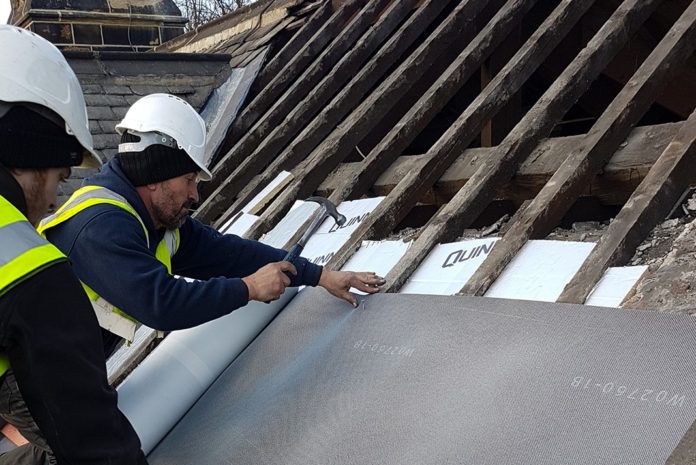This imposing Gothic revival mansion has been used as the Calderdale Registry Office since 2009, although since it was built in 1871, it has been used as a WW1 hospital, a guest house and a ballet studio. There was a complete internal renovation in 2009, creating office space in the upper storey, but only now has it been re-roofed – which of course then requires an upgrading of the insulation.
How was the heat loss reduced?
Since an uninsulated roof has a U value of 3.87 W/m2K – which means that for every square metre 3.87 Watts of heat are being lost for every degree temperature difference between the outside and inside – the office workers in the rooms in the roof must have been freezing! This may have been the norm when it was accommodation for the servants, but it is not acceptable now, nor desirable in terms of energy loss.
Rafter-level insulation was the only solution
There was little scope for improvement, however, as the rafters were only 75mm deep. The loft void was too small and inaccessible to consider putting insulation over the ceiling, so rafter-level insulation was the only option. With 75 mm rafters the build-up would normally be to use a breather membrane and 50mm PIR board and a vapour barrier beneath, but over the sloping ceiling sections there were lath and plaster ceilings, which meant that the effective rafter depth was reduced.
A tempting home for bats too?
A final complication was that, although a survey had shown no evidence of bats in the roof, the proximity of woodland meant that there was a possibility that bats may use it in future.
Since bats become tangled in fibres, there is a requirement to use a bitumen felt where they are found to be using a roof. The problem here from an insulation build-up perspective is that this then requires a 50mm ventilated space underneath. If this were to be implemented in the roof overlying the offices, then in 75mm rafters with a 50mm ventilated space and a lath and plaster ceiling intruding this would leave room for no insulation at all – so the office workers would continue to freeze and Calderdale Council would be seeing heat vanish!
A membrane which is both energy saving and no danger to bats
A pragmatic solution was found by making use of TLX bat safe breather membrane. This is a standard BBA-certified breather membrane sandwiched between two layers of mesh. The mesh is sufficiently small to prevent bat claws from pulling out fibres from the breather membrane below, yet will offer space for them to crawl around on.
What about testing?
It started its development in 2014 and has been tested extensively, firstly with live tests at the IOW Bat Hospital, followed by rigorous lab testing using the industry recognised pilling test method and finally a fibre filament test.
Result?
By using Batsafe this meant that 30mm of PIR board could be accommodated, which allowing for the usual membrane drape and the lath and plaster intrusion, was able to achieve a U value <0.7 W/m2K, which corresponds to an 82% saving in heat loss.
Calderdale Council makes considerable savings in heating bills, the office workers are warmer, and should any bats take up residence they will be safe.




